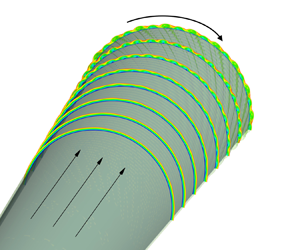Published online by Cambridge University Press: 12 September 2023

In this paper, we present a systematic study of the nonlinear evolution of the travelling Mack modes in a Mach 3 supersonic boundary layer over a rotating cone with a  $7^{\circ }$ half-apex angle using the nonlinear parabolic stability equation (NPSE). To quantify the effect of cone rotation, six cases with different rotation rates are considered, and from the same streamwise position, a pair of oblique Mack modes with the same frequency but opposite circumferential wavenumbers are introduced as the initial perturbations for NPSE calculations. As the angular rotation rate
$7^{\circ }$ half-apex angle using the nonlinear parabolic stability equation (NPSE). To quantify the effect of cone rotation, six cases with different rotation rates are considered, and from the same streamwise position, a pair of oblique Mack modes with the same frequency but opposite circumferential wavenumbers are introduced as the initial perturbations for NPSE calculations. As the angular rotation rate  $\varOmega$ increases such that
$\varOmega$ increases such that  $\bar \varOmega$ (defined as the ratio of the rotation speed of the cone to the streamwise velocity at the boundary-layer edge) varies from 0 to
$\bar \varOmega$ (defined as the ratio of the rotation speed of the cone to the streamwise velocity at the boundary-layer edge) varies from 0 to  $O(1)$, three distinguished nonlinear regimes appear, namely the oblique-mode breakdown, the generalised fundamental resonance and the centrifugal-instability-induced transition. For each regime, the mechanisms for the amplifications of the streak mode and the harmonic travelling waves are explained in detail, and the dominant role of the streak mode in triggering the breakdown of the laminar flow is particularly highlighted. Additionally, from the linear stability theory, the dominant travelling mode undergoes the greatest amplification for a moderate
$O(1)$, three distinguished nonlinear regimes appear, namely the oblique-mode breakdown, the generalised fundamental resonance and the centrifugal-instability-induced transition. For each regime, the mechanisms for the amplifications of the streak mode and the harmonic travelling waves are explained in detail, and the dominant role of the streak mode in triggering the breakdown of the laminar flow is particularly highlighted. Additionally, from the linear stability theory, the dominant travelling mode undergoes the greatest amplification for a moderate  $\varOmega$, which, according to the
$\varOmega$, which, according to the  $e^N$ transition-prediction method, indicates premature transition to turbulence. However, this is in contrast to the NPSE results, in which a delay of the transition onset is observed for a moderate
$e^N$ transition-prediction method, indicates premature transition to turbulence. However, this is in contrast to the NPSE results, in which a delay of the transition onset is observed for a moderate  $\varOmega$. Such a disagreement is attributed to the different nonlinear regimes appearing for different rotation rates. Therefore, the traditional transition-prediction method based on the linear instability should be carefully employed if multiple nonlinear regimes may appear.
$\varOmega$. Such a disagreement is attributed to the different nonlinear regimes appearing for different rotation rates. Therefore, the traditional transition-prediction method based on the linear instability should be carefully employed if multiple nonlinear regimes may appear.